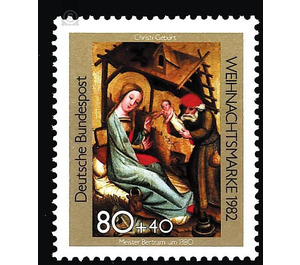Christmas - Germany / Federal Republic of Germany 1982 - 80 Pfennig
| Country | Germany / Federal Republic of Germany |
| Issue Date | 1982 |
| Face Value | 80.00 |
| Color | brown |
| Perforation | K 14 |
| Printing Type | 8-color offset |
| Stamp Type | Postage stamp |
| Item Type | Stamp |
| Chronological Issue Number | 1034 |
| Chronological Chapter | GER-BRD |
| SID | 308693 |
| In 45 Wishlists | |
The Deutsche Bundespost issues the Christmas stamp with a supplement in favor of the "Freie Wohlfahrtspflege", whose organizations help wherever government aid is insufficient. The panel, painted on oak wood, belongs to the Petri altar of Master Bertram, now in the Hamburger Kunsthalle. The painter was probably born around 1340 and comes from Minden in Westphalia. Mentioned in a document in Hamburg since 1373 as a master with his own workshop, Master Bertram is the first known artist of Hamburg and at the same time one of the most important painters of his time. The Buxtehuder Marienaltar and the small Harvestehuder Altar, all today in the Hamburger Kunsthalle, also come from his workshop, which also executed carvings in addition to painting. Highly respected and with a considerable fortune, Master Bertram died in 1414 or 1415 in Hamburg. The altar bears the inscription on the back of the year 1380th He was, however, only in 1383 as the main altar in the St. Peter's Church in Hamburg. The pictorial program of the winged altar measuring 1.80 meters in height and 7.20 meters in width covers the salvation process from creation to the life of the first parents and scenes from the Old Testament through to the youth of Christ , The sculpture shrine in the interior of the altar visible only on open sails on high holidays shows the crucifixion. Like all the panels of the altar, "The Nativity" is painted on a gold background. With this, Master Bertram emphasizes the sacred and solemnity of the depicted scene. At the same time, however, the picture is characterized by a striking narrative joy, which in this world exactly reproduces the feed basket for ox and donkey or the pot with porridge on the fire. And yet Master Bertram is initially not really interested in a true-to-life account. Thus, the decaying hut, the damaged wicker fence, the bed on the ground or the loving care of the child by Joseph are only superficially evidence of close observation. In fact, it is an ancient tradition, partly borrowed from Byzantine traditions, to illustrate that the Son of God has accepted human nature and shares with human beings all the wretchedness and hardships of earthly existence. In the beautiful, colorfully shining color and in the fashion influenced by contemporary fashion, it becomes clear how much Master Bertram participates in the tendencies of a refined international Gothic style, which dominated Europe in the 1400s. Master Bertram was right in assuming the influences of the then leading Bohemian painting, which was particularly influenced by the new bodily art of Italy. Relationships also arise to the Westphalian altarpiece, on which, however, Bertram has greatly reduced. In the touching and composed humanity of his characters, in the revival of old motifs as in the invention of new image concepts, in the balance between spiritual content and tangible reality counts Bertram's Petri altar to the greatest creations of German painting in the Middle Ages. (Text: Hamburger Kunsthalle)


